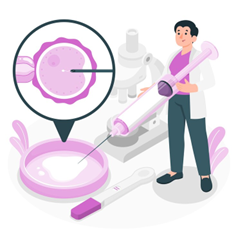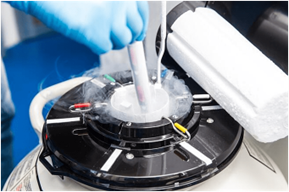Embarking on the journey of assisted reproduction brings with it a plethora of choices, one of which is the natural frozen embryo transfer (FET). Users praise this method for aligning with the body’s natural cycles. It stands out as a beacon of hope for many aspiring parents. It’s a technique refined and advocated by some of the best IVF doctors in India.
Dr. Hrishikesh Pai, an inspiration in the field of reproductive medicine, has been instrumental in pioneering advanced IVF treatment in India. He is an expert in Frozen Embryo Transfer Treatment in India.
Ready to embark on your journey to parenthood? Get our expert guidance. Schedule your consultation now!
Curious about what exactly natural FET is? Learn more with us!
What is Natural Frozen Embryo Transfer?

Natural frozen embryo transfer is a procedure that involves transferring a previously frozen embryo into the woman’s uterus during her natural menstrual cycle. This method avoids using extra hormones. Instead, it relies on the body’s own hormonal signals to prepare for implantation. It mirrors the natural conception process as much as possible.
Wondering what the natural FET process looks like? Follow along as we break down each step, making the complex simple.
The Process of Natural FET
The process of Natural Frozen Embryo Transfer (FET) involves several detailed steps to ensure that the embryo transfer aligns with the natural menstrual cycle of the patient. Here’s a step-by-step breakdown:

- Watching Your Cycle: The clinic keeps an eye on your menstrual cycle to find the best time for the embryo transfer. This means checking when your body is naturally ready to accept an embryo.
- Spotting the LH Surge: You’ll use tests to find a surge in a hormone (LH) that tells us ovulation (when an egg is released) is close. This surge is our cue to get ready for the next steps.
- Setting the Transfer Date: Once we see the LH surge, we plan when to put the embryo into the uterus. This timing is key in helping the embryo stick.
- Getting the Embryo Ready: The frozen embryo is thawed and prepared for the transfer.
- Putting the Embryo In: A doctor gently places the thawed embryo inside the uterus. This is usually quick and doesn’t hurt.
- After the Transfer: You can get back to normal stuff pretty soon after, but the clinic might give you a few tips on what to do next.
- Checking if It Worked: About two weeks later, you’ll take a test to see if the embryo has attached to the uterus and started a pregnancy.
Want to understand more about the Natural FET procedure? Don’t wait and contact us now for expert guidance.
But wait, Do you know there’s more about the Preparation for natural FET? Here’s what you need to understand.
Preparing for Natural Frozen Embryo Transfer
Getting ready for a Natural Frozen Embryo Transfer is all about syncing with your body’s natural cycle and making sure you and the embryo are set for a successful transfer. Here’s a quick rundown:

- Track Your Menstrual Cycle
- Healthy Lifestyle Choices
- Monitor Ovulation
- Go to Check-Ups
- Prepare the Embryo
- Follow Specific Instructions
- Plan for the Day of Transfer
Why choose natural FET? Get a more clear understanding of its benefits by talking to the specialists. Book an appointment!
Guess what? The benefits of natural FET extend far beyond what you might initially think. Read further more.
Advantages of Natural FET
The natural Frozen Embryo Transfer (FET) process comes with some great benefits that make it an appealing choice for many.

- Less Stress on Your Body: Skipping extra hormones makes the whole process easier on you, both physically and emotionally.
- Cost-Effectiveness: The FET cycle requires less medications and interventions. This makes it a financially viable option for many couples.
- Enhanced Success Rates: Matching the embryo transfer with your natural cycle may improve the chances of implantation and pregnancy, as the endometrial lining is at its most receptive.
- Natural Cycle Synchronization: This method works with your body’s normal cycle, making it a more organic and less invasive approach to embryo transfer.
Let’s understand how successful this process can be with some real – time statistics!
Natural Frozen Embryo Transfer Success Rate

Success rates for natural frozen embryo transfer have been encouraging, often matching or surpassing those of traditional hormone-supported transfers. This is attributed to the selection of a naturally optimal time for embryo implantation.
Even though Natural FET has its advantages, it also comes with its Challenges! Read along and be mindful about it.
Considerations and Challenges
While natural FET offers many advantages, it may not be suitable for all patients. Factors such as irregular cycles or certain fertility issues might need alternative approaches.
- Suitability Concerns: Natural FET may not be the right choice for all individuals or couples.
- Irregular Menstrual Cycles: Patients with irregular cycles might find it difficult to pinpoint the optimal timing for embryo transfer.
- Specific Fertility Challenges: Certain fertility conditions could need alternative, more specialized treatment approaches.
Every journey has its hurdles, but with the right information, you can navigate them successfully. Click here to talk more about it with the expert.
Conclusion
Natural frozen embryo transfer represents a significant step forward in personalized, patient-centric fertility treatment. Dr. Hrishikesh Pai’s expertise highlights the options for couples who want to expand their families through IVF treatment in India. This treatment offers a blend of nature and science that is both effective and respectful of the body’s natural rhythms.
Embarking on your IVF journey with natural FET? Reach out today!
FAQs
- Is a natural frozen embryo transfer better?
It can be, especially for women with regular menstrual cycles and those who prefer a less medicated approach. It offers the advantage of fewer side effects and a more cost-effective treatment.
- What is the success rate of natural IVF transfer?
Success rates vary widely, but natural IVF transfer often shows comparable success rates to conventional IVF, especially in selected patient groups.
- Can natural FET be done with embryos from IVF cycles?
Yes, natural FET can be performed with embryos obtained from previous IVF cycles, offering a flexible and less invasive option for utilizing frozen embryos.

